Winter Farm Fields, Wildlife Sanctuary
Wilkins Farm, Groton, MA

Late last fall, a large flock of house finches roosting in a local cornfield caught my attention. I followed them into the field.
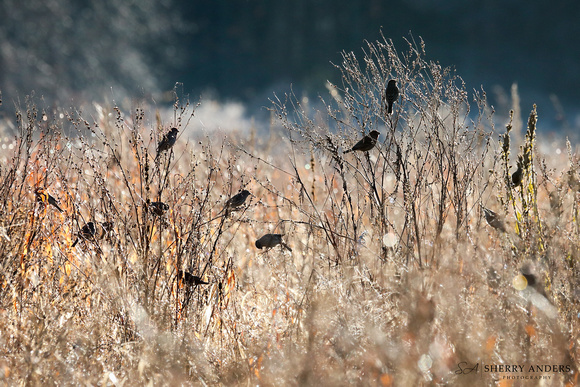
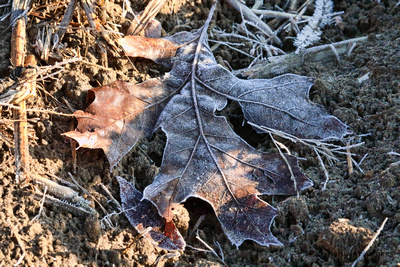
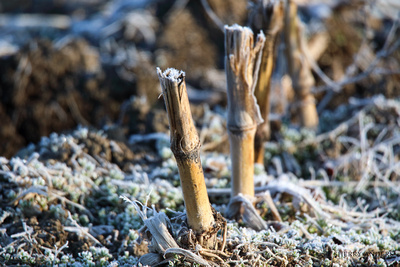
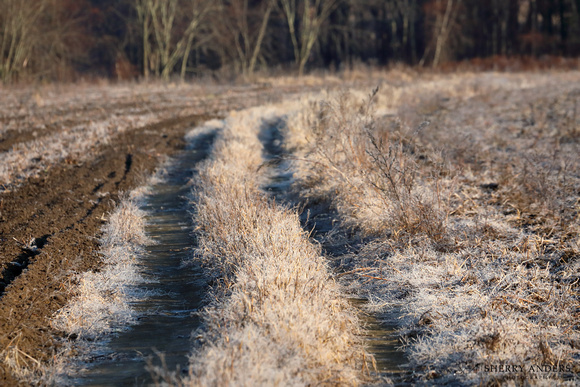 Along with the finches, soon other flocks of birds appeared. They fed on unplowed cornstalks, dried meadow plants, berries, and insects, and took shelter in the brush along a little stream that cuts through the farm.
Along with the finches, soon other flocks of birds appeared. They fed on unplowed cornstalks, dried meadow plants, berries, and insects, and took shelter in the brush along a little stream that cuts through the farm.
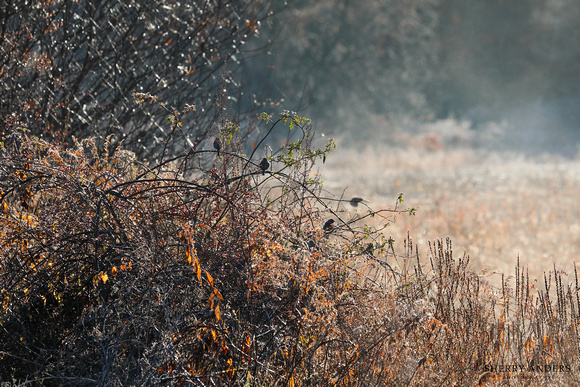
Cedar waxwings picked over the crabapples and chokeberries. Often fermented this time of year, the fruit can have the effect of intoxicating birds and other animals, and cedar waxwings have a grand reputation for enjoying this.
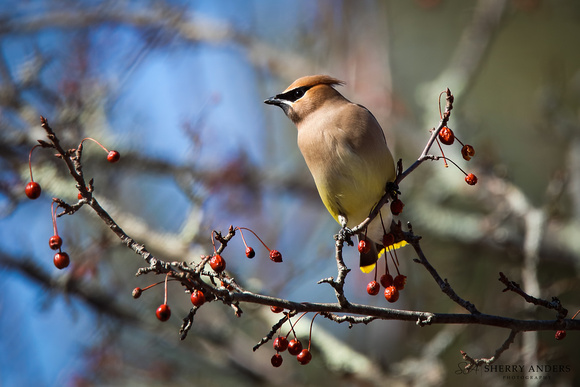
Bluebirds gathered in the trees, enjoying a variety of berries left to be picked over, and pulling worms from the fields, not yet frozen.

Insects sheltered in the corn husks.

In an adjacent field various types of squash were left behind from the autumn harvest, full of tasty seeds.
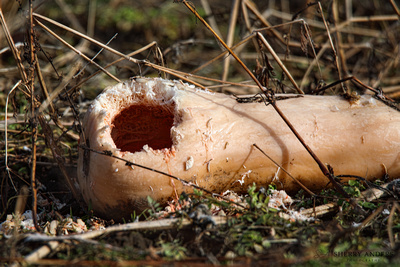
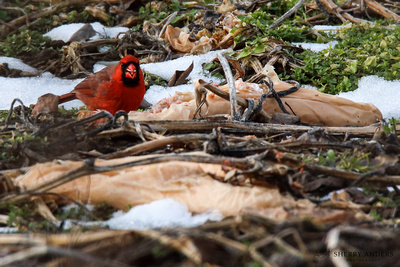
Periodic visits in December and January led me to discover that white-throated sparrows, song sparrows, cardinals, and blue jays were steady regulars, and could often be found in a mix with house finches, American goldfinches, and dark-eyed juncos.

Crows travelled in large groups, moving from trees to field and back again. Robins, red-winged blackbirds, starlings, and a lone raven made fleeting appearances, and from time to time a nuthatch would appear, exploring tree cavities. Small groups of black-capped chickadees and tufted titmice stopped by to forage, but seemed to prefer the wooded edges of the fields.
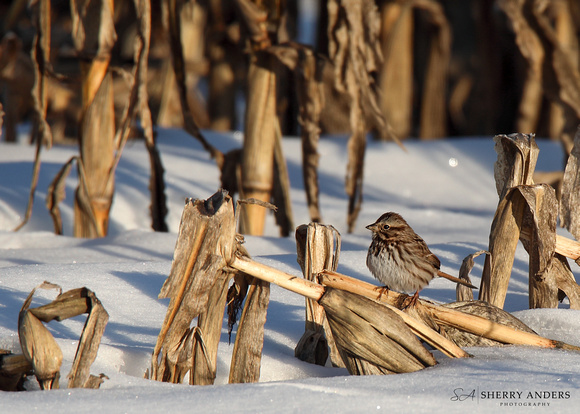
A kind birdwatcher who had discovered this field as a birding treasure pointed out a tree sparrow, a colorful sparrow that breeds in northern Canada and Alaska and migrates south for the winter.

White-throated sparrows were quite vocal and their distinctive whistle, “Oh sweet Canada, Canada,” rung out as a descant to the harsher cries of crows and jays, and woodpeckers jackhammering in the trees.
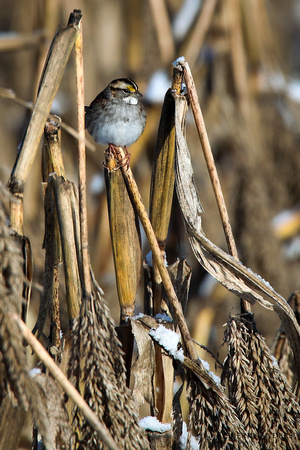
A red-bellied woodpecker frequented several large shagbark hickory trees along a dirt road that passes through the center of the fields, along with a number of downies. Pileated woodpeckers could be heard in the large white pines and oak trees that skirted the fields, and occasionally visited the beautiful shagbarks, too.
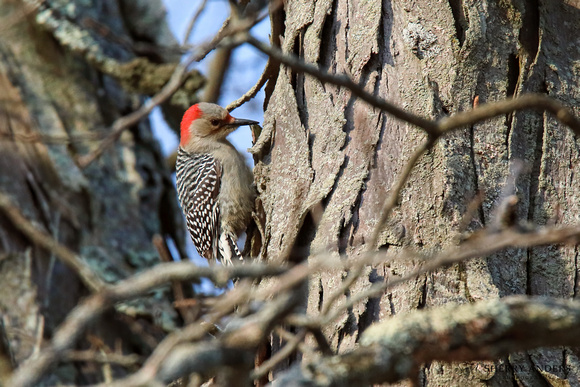
While woodpeckers enjoyed foraging for insects in the shagbarks, they were well-appreciated as a resting spot by many of the birds passing through, and offered great perches for hawks.

A juvenile cooper’s hawk and a red-tailed hawk regularly stopped by to eye the smaller birds and squirrels, each seeming to keep to their own territory. One frosty morning in January I found a pellet under the tree where the cooper’s hawk liked to perch. At first I assumed it was an owl pellet, but when I opened it up it lacked the typical bones one would find and I surmised it was a hawk pellet, as hawks are able to digest the bones of their prey.
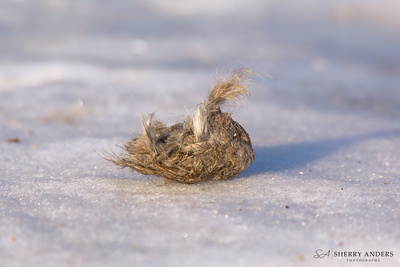
On another occasion I found four crows pursuing the cooper’s hawk, who must have done something to offend. The hawk landed in a tree right above my head, perhaps thinking the crows would find me too intimidating to follow it there. At least one of the crows was undaunted, however, and off they went.
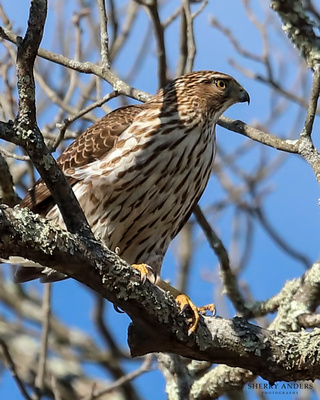
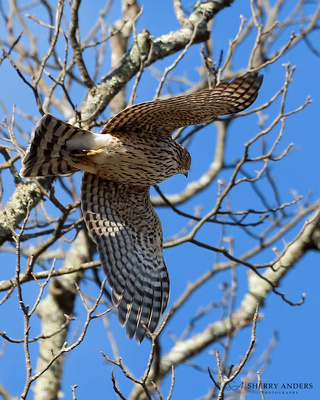
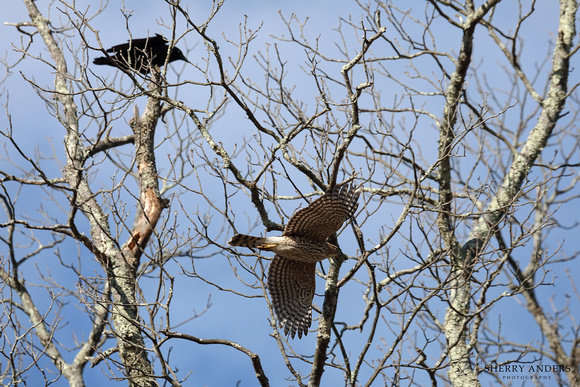
Most mornings deer could be seen along the forested edges of the fields, and their tracks throughout the entire area indicated that this was a favorite spot for foraging.
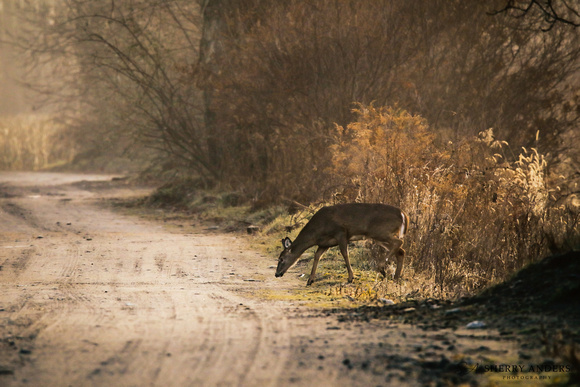
Fox and coyote tracks, along with those of smaller animals like raccoons, rabbits, squirrels and mice were also spotted.
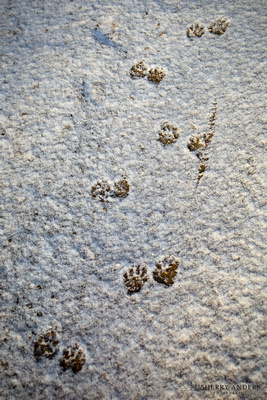
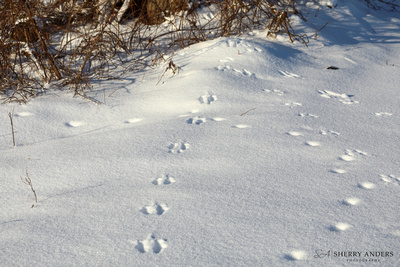
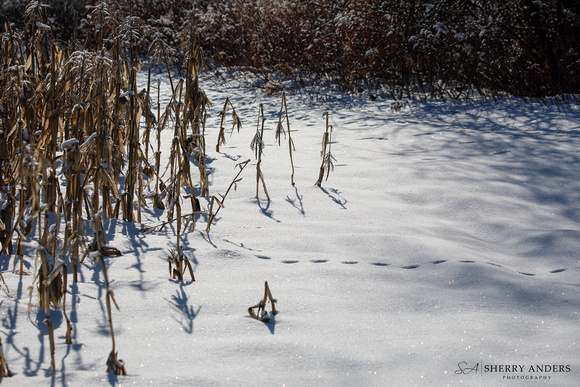
Nearing spring, coyotes could be heard in the adjacent woods, and I occasionally caught glimpses of them if I arrived early enough.
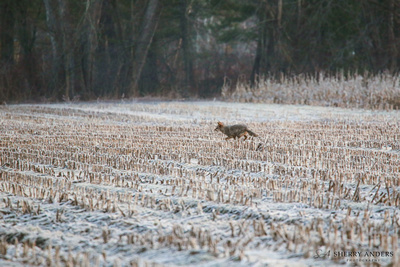
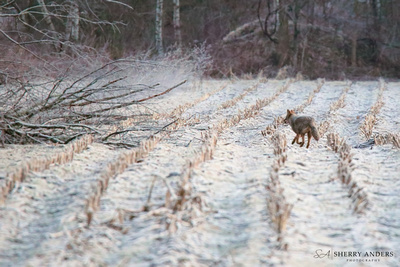
Squirrels could almost always be seen scurrying up and down the trees, or popping in and out of small holes in the bark.
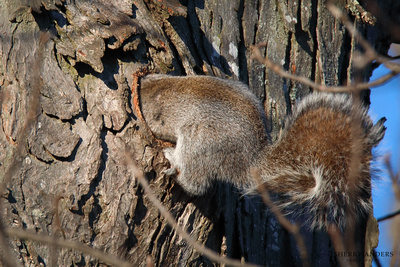
Once a frozen ear of corn fell out of a tree as I walked past, and I can only imagine that a squirrel hauled it up there in a mighty attempt to squander its feast. On another occasion, an ear of corn had been pulled up into a shrub. Although a squirrel likely placed it there, the birds seemed to enjoy taking turns at it.
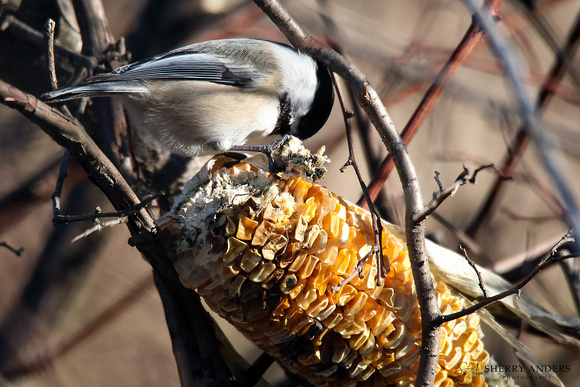
With the Nashua River flowing just beyond the field, Bald Eagle flybys were not uncommon, and occasionally one could be found perched at the far end nearest to the river.
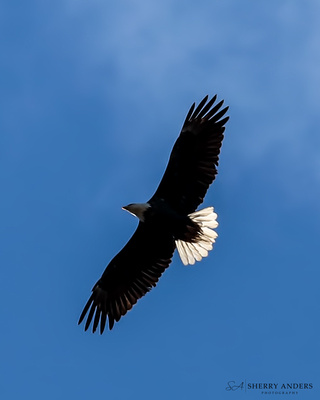
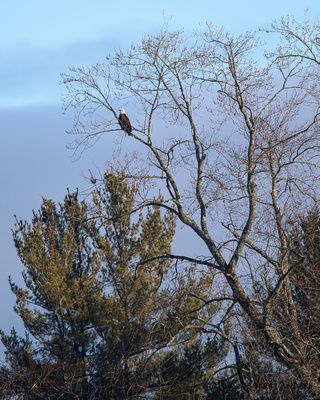
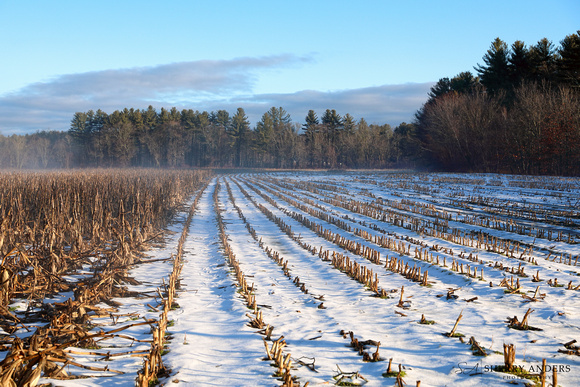
Throughout the winter, remnants of the farming season were left scattered in the fields – harvesting buckets, ploughing equipment, and a bright red tractor that, much like the male cardinal, brightened the wintry landscape.
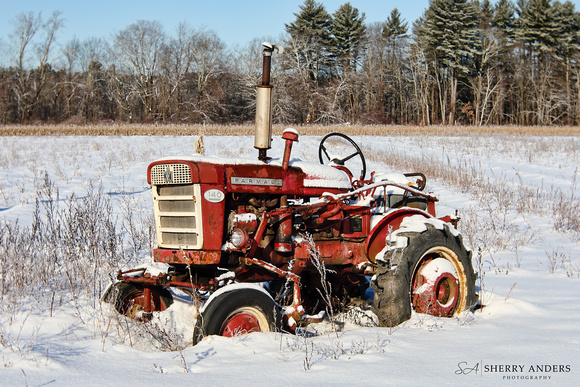
What may have looked like dry, dormant fields, to an outsider, were far from lifeless. Counting over 30 species of birds, 8 mammals (some identified by tracks), and a variety of insects that took shelter in the corn husks, the fields offered welcome food and sanctuary to wildlife big and small.
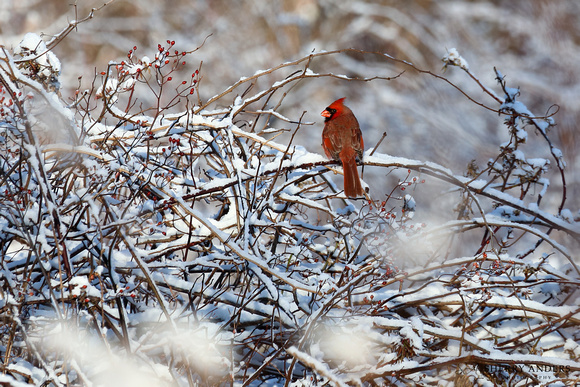
]]>
Frozen: New England Wildlife and the Winter Landscape
Winter can be a challenging time for animals here in New England. In addition to cold temperatures, snow and ice transform the landscape in ways that impact their ability to hunt and forage. Last year a thick layer of snow melted and refroze as ice, making it difficult for ground animals to move around and for raptors to hunt. Young barred owls were brought to animal rehabilitation centers in record numbers sick, hungry, or injured. When the ground is covered in snow or ice, owls and other raptors are more apt to hunt near roadways and to be struck by cars.
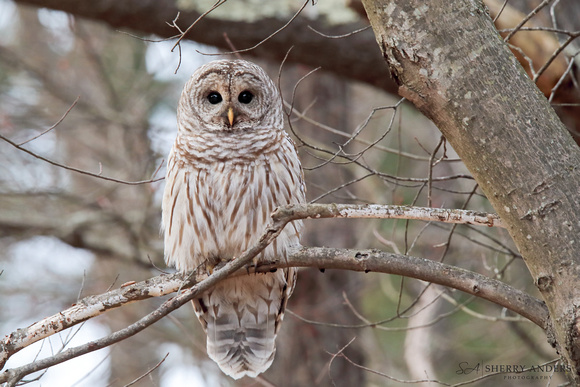
This barred owl was perched along a busy road in daylight, an indication that it may have been having difficulty finding prey.
Animals adapt to the season in different ways. Some, of course, hibernate or migrate. A good number remain active, however, and birds like snow buntings, tree sparrows, dark-eyed juncos, snowy owls, and a variety of waterfowl arrive from the North.
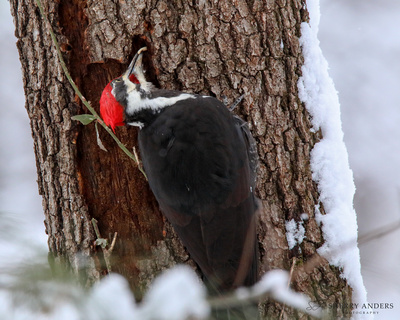
Birds have unique adaptations that help them survive the cold temperatures, and they manage to stay warm in a number of ways. For example, they are able to avoid frostbite by having very little fluid in their feet and quickly circulating blood. Their blood vessels are spaced close together so that blood flowing to the feet warms the blood that is flowing back into the body. Another way they stay warm is by standing on one foot, with the other tucked up under their downy feathers. Some lower their whole bodies down to cover their feet. You might also find them with their feathers fluffed out, which helps trap the warmth from their bodies.
A year-round resident in New England, this pileated woodpecker is pulling a tasty grub from the tree.
Waterways are important in winter adaptation and survival. Geese, swans, mergansers, and other ducks gather in pockets of unfrozen water to look for food. If you are lucky you may come across some of the more interesting varieties like hooded mergansers, buffleheads, ring-necked ducks, or goldeneyes.
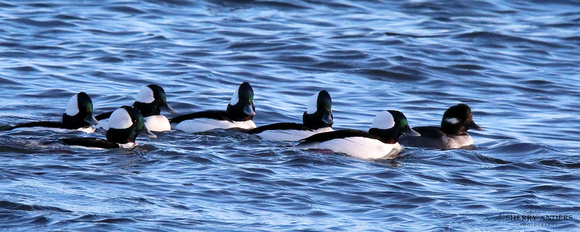
Bufflehead ducks from Canada winter in New England and other parts of the United States.
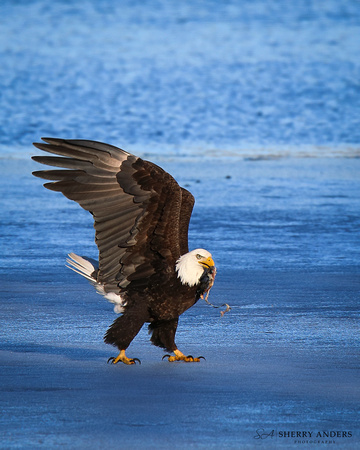
Rivers and ponds are not just important for waterfowl. Bald Eagles hunt along the waterways, even when they are frozen over with ice. They look for ducks and for fish along the edges of the ice, where it’s thinnest. They will also feed on carrion. Osprey prefer fish and will head off to warmer regions for better access to food.
Beavers, river otters, and mink remain active in rivers and ponds throughout the winter, as well. Otters and mink hunt beneath the frozen surface of the water. Beavers’ lodges become encapsulated in snow and ice which helps to keep predators out, and they rely on stored food and fat reserves in their tails to survive the coldest months.
This bald eagle captured its dinner by “ice fishing,” pulling its prey out of a small hole the ice.
As animals scope the landscape for food and water, both predator and prey activity along the water’s edge increases. Mice shelter in rocky areas along the riverbanks. Foxes, coyotes, and bobcats can now traverse the frozen waterways and have access to a wider hunting range. Frozen waterways allow small animals and foragers like moose and deer to gain wider access to food, as well.
This bobcat was sunning itself on the river early one morning. From a distance, I watched it walk across the ice. Realizing it wouldn’t make it across to the other bank, it turned back and quickly surveyed my presence before disappearing into the woods.
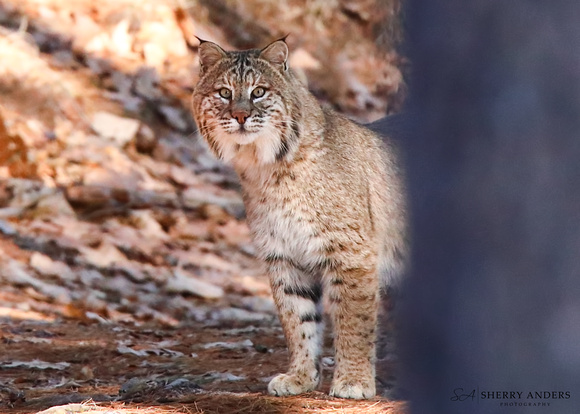
Plum Island, Massachusetts
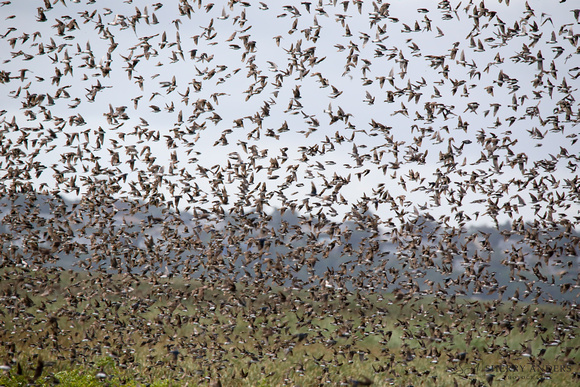
The annual gathering of tree swallows on Plum Island, Massachusetts, peaks in late August and is spectacular to watch. A key stop on the eastern migration route, thousands upon thousands gather, feasting on the island's ample supply of bayberries to shore up energy for their journey south.
With an ebb and flow that seems to pick up pace throughout the day, dense flocks rise from the thicket in swirling arrays and settle back into the landscape.
A tree swallow's usual diet consists of flying insects, but the bayberry seeds they find on the island offer a highly concentrated source of energy, and tree swallows are one of the few birds able to digest the waxy fruit that covers the seeds. They will also eat winterberry and viburnum along their route.

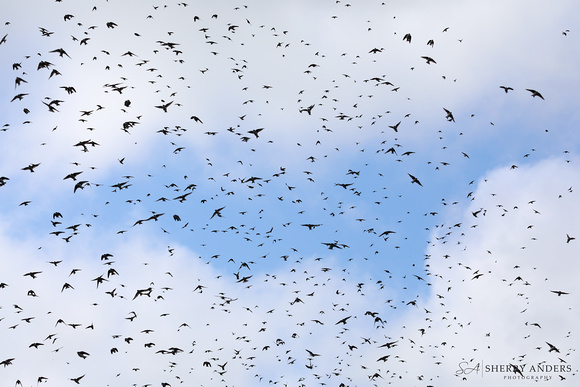
During breeding months, tree swallows are found throughout the United States and Canada. Wintering grounds for these northeastern migrators typically range from Florida to Central America. In March they will return to the Northeast as welcome harbingers of Spring.
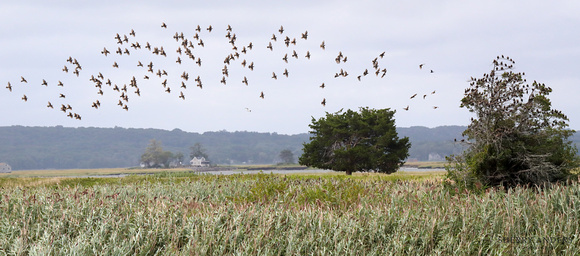
]]>
Cape Cod, Massachusetts
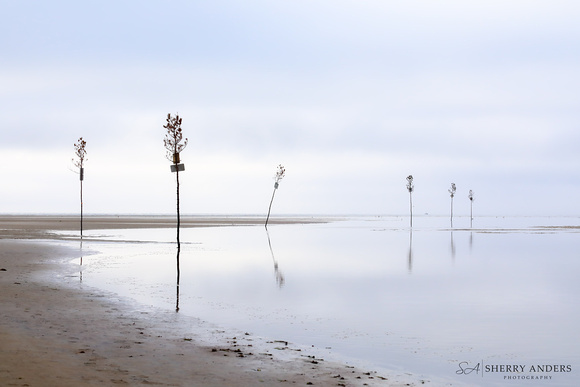
At Rock Harbor, a row of young pine trees with old street signs attached to them extends into the bay, giving the appearance of a modern art installation.

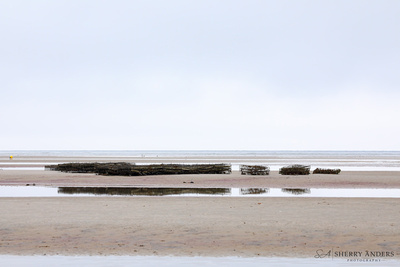
At low tide, visitors can walk up to the trees, which appear to be growing right out of the sand. Known to the locals as “clam trees,” legend has it that back in the 70’s, quahoggers who used to harbor there dropped clams near the bases of the trees. Later in the season when permit holders dug for clams, they’d have the best luck near the trees. Locals would claim that the clams fell from the trees.
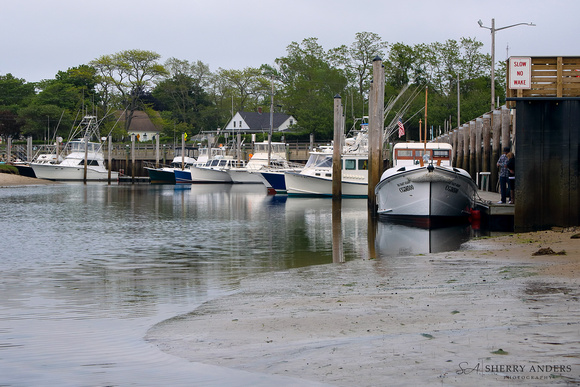
“Clam trees” are installed along the waterway each spring to help boats navigate in and out of the man-made harbor. The reflectivity of the signs helps guide the boats, and the trees show up on radar. A small commercial and charter fishing fleet docks at the harbor, located on the border of Orleans and Eastham.
Rock Harbor attracts many visitors and beachcombers, touted as one of the most picturesque places on the Cape for sunset viewing.
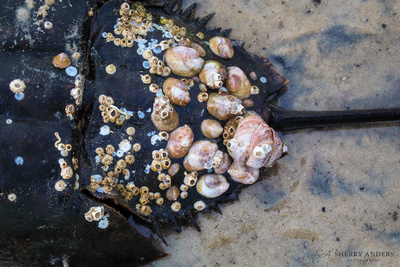
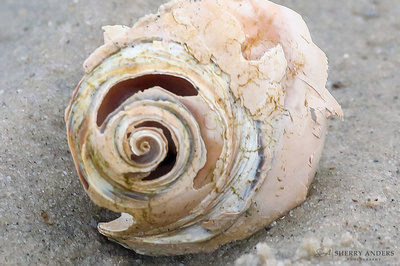
The coastal shoals are your dominion,
No salmon, or smelt, nor bottom flounder
Had ever left the sea until you struck,
You are wraith to the kelp beds dream.

A young osprey claims this tree in a shallow pond as its nesting site. The first few sticks fall straight into the water, but he persists. Ospreys, sometimes called fish hawks, prefer open, elevated nests near shallow waters that provide an ample supply of fish.
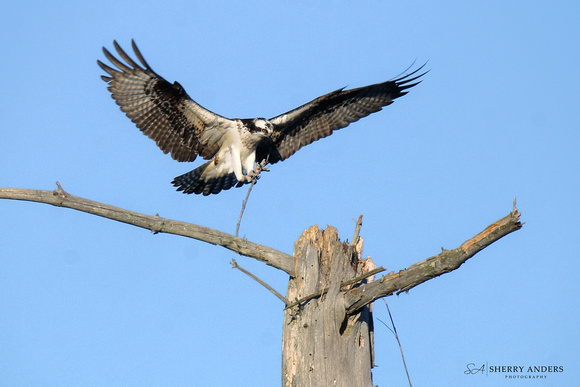
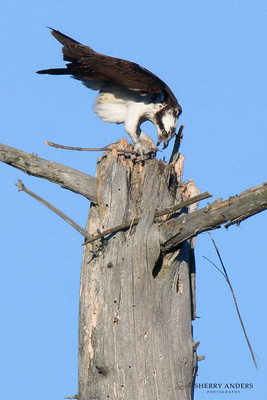
Determination triumphs. Stick by stick, the nest takes shape. When it is ready, the osprey is joined by its mate.
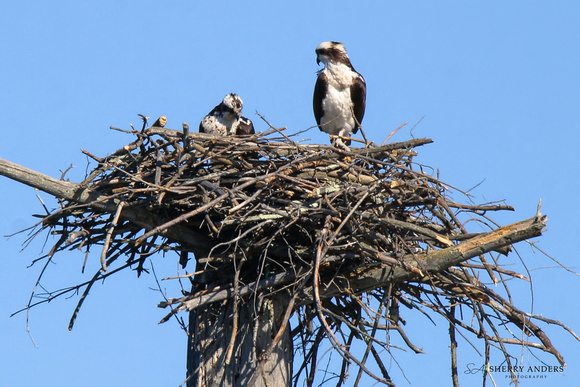
Courtship is underway.
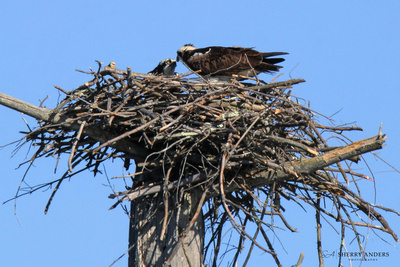

The male osprey performs “sky-dances” or “fish-flights” to impress the female. It hovers in the air with a fish in its talons, followed by shallow swoops and cries.
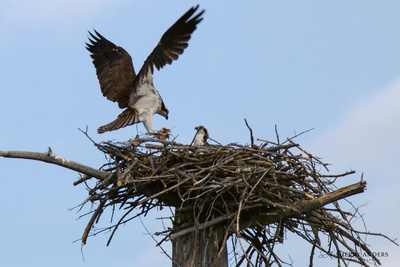
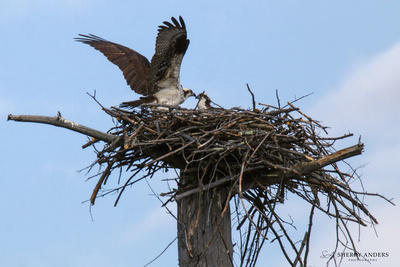
Ospreys have a fierce reputation. In his essay Natural History of Massachusetts, Henry David Thoreau wrote, “Its shrill scream seems yet to linger in its throat, and the roar of the sea in its wings. There is the tyranny of jove in its claws, and his wrath in the erectile feathers of the head and neck.” During courtship and chick-rearing, a less-noted tender side prevails, observed as the birds lock gazes, nuzzle, and share food.
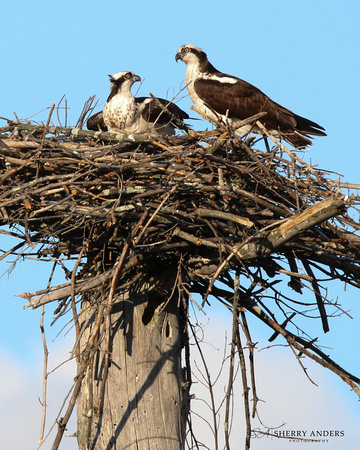
With a diet almost entirely comprised of fish, the male osprey typically catches a fish, sits in a nearby tree and eats exactly half of it, then returns to the nest with the other half for its mate. The female stays close to the nest, carefully watching over the eggs. She also stays with the chicks when they hatch.
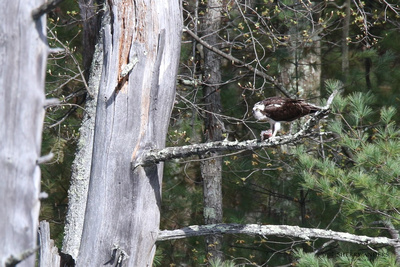
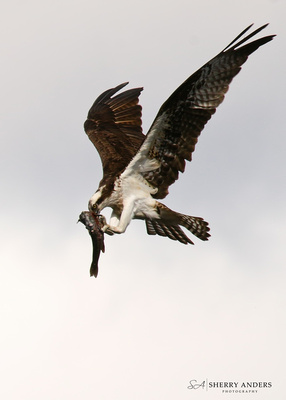
When the chicks hatch, the male osprey brings fish back to the nest for the whole family.
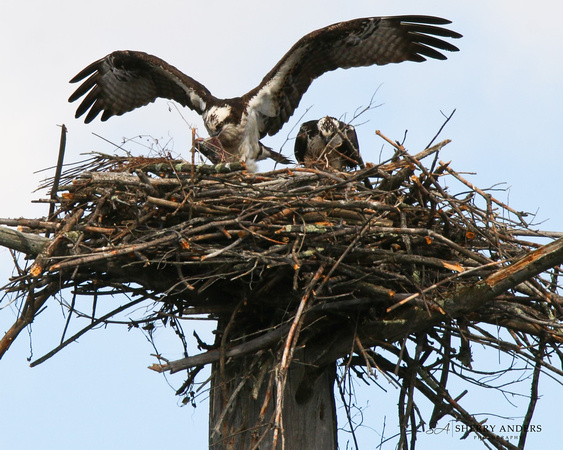
Crowded out by the growing chicks, this male osprey often rests on a nearby branch while the female tends the nest. Two osprey chicks are successfully reared by this pair and ultimately fledge.
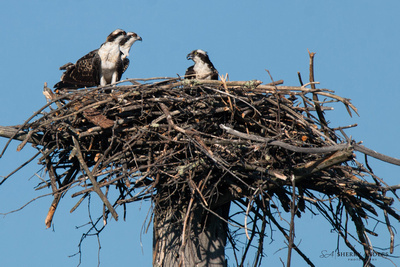

Note: This osprey family was observed in Ayer, Massachusetts. Once on the verge of extinction due to pesticides, the banning of DDT in 1972 combined with focused conservation efforts have led to a great resurgence in New England's osprey population. Their numbers continue to rise.
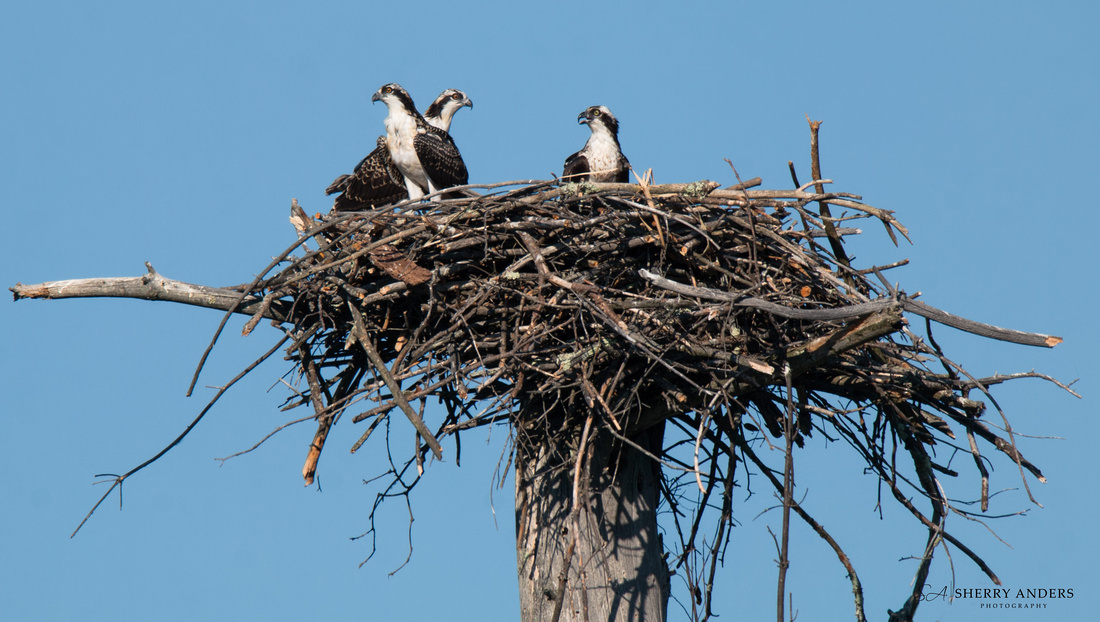
]]>
From Maine Coast Heritage Trust's online publication documenting the history of Islands in the Merchant Row Archipelago:
"Named after William Barter, an early settler of Isle au Haut, this 5-acre island was likely used for sheep-grazing from the early 19th century until 1965 (when the last sheep were removed). A small camp constructed in the 1960s on the island was removed in 2010 and was reused on Isle au Haut (with the unwanted portion burned). Bill's Island came to Maine Coast Heritage Trust in 2005 through a gift from the estate of Mary M.B. (Polly) Wakefield (whose family had strong ties to Isle au Haut) who had wanted the island remain a natural haven."
http://www.mcht.org/preserves/docs/Merchant%20Row%20History.pdf
Here are some photos of Bill's Island from a recent trip in early September.

A small sand beach at low tide
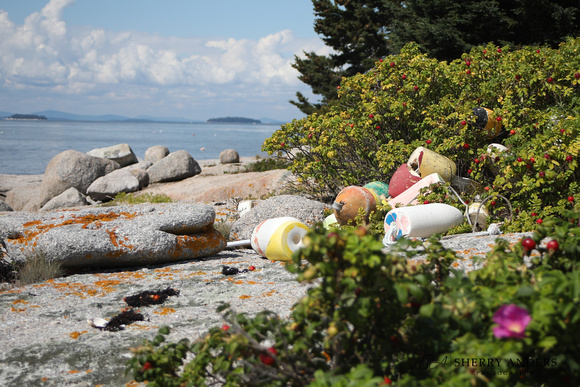
Rose hips and lobster buoys, with just a few beach roses still in bloom
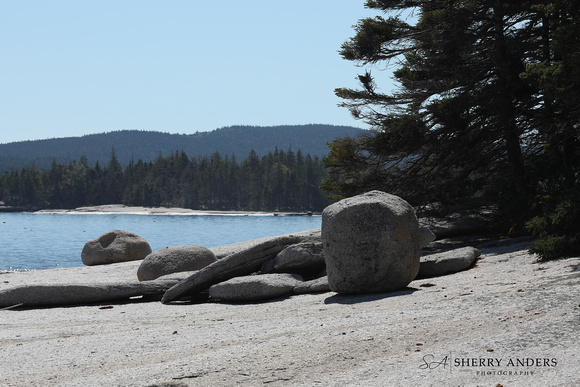
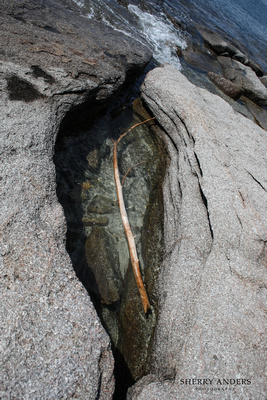

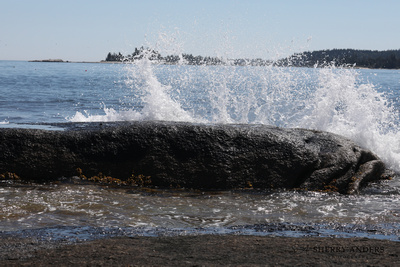
Granite rock formations
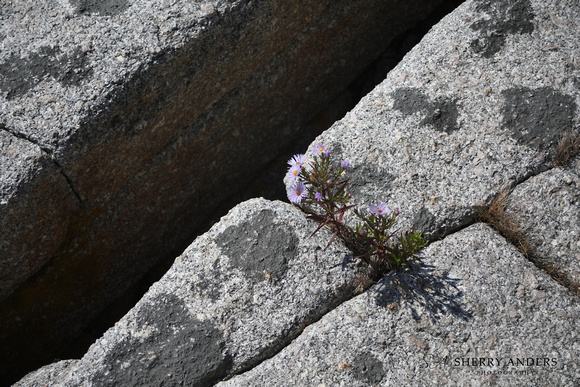
Sign of impending autumn; aster sprouting from a rock crevice

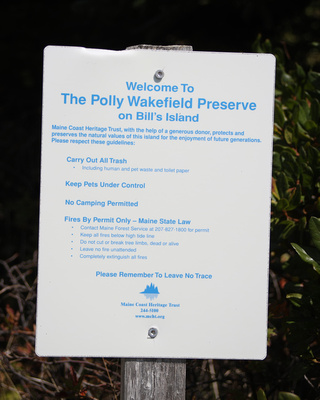
The edge of the spruce forest and welcome sign
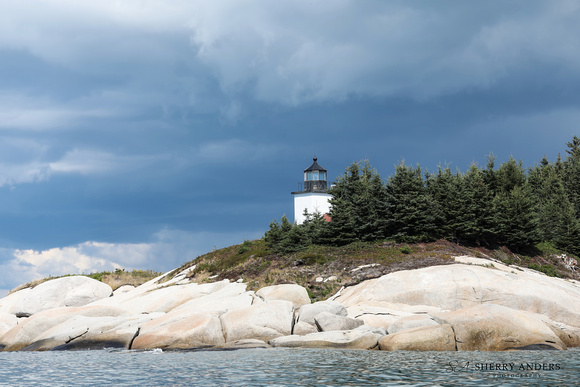
Nearby Mark Island Lighthouse
]]>
The surface glittered out of heart of light"
-T.S. Eliot, from Burnt Norton, "Four Quartets"
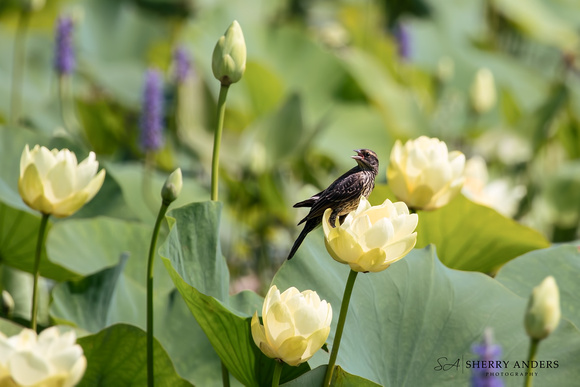
The lotus flower symbolizes purity and transcendence. Rooted in mud and murk, the lotus rises above the surface of the water to bloom. Great Meadows National Wildlife Refuge in Concord becomes a sea of lotus blossoms during the peak of summer each year. The lotuses that bloom at Great Meadows are American Lotuses, a non-native species that has taken over the two large pools at the refuge. A variety of herons and ducks can be found lurking among the giant leaves of the lotus plants, while red-winged blackbirds can be found perched on the leaves and blooms.
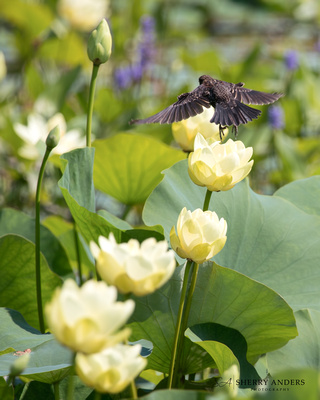
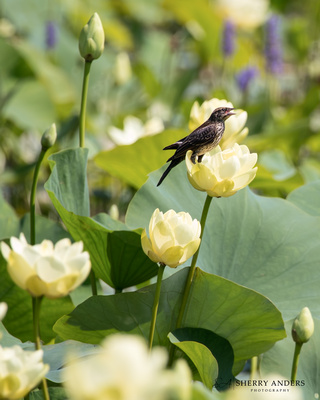
Immature red-winged blackbird perched on an American Lotus Flower
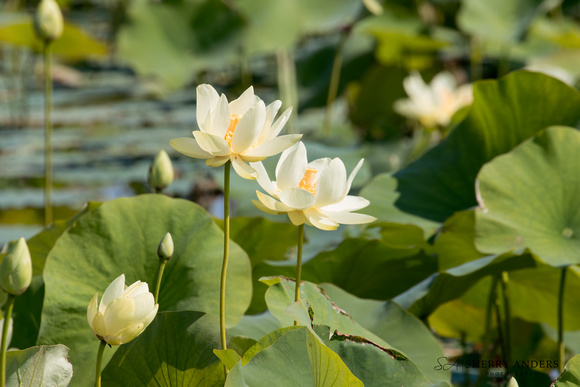
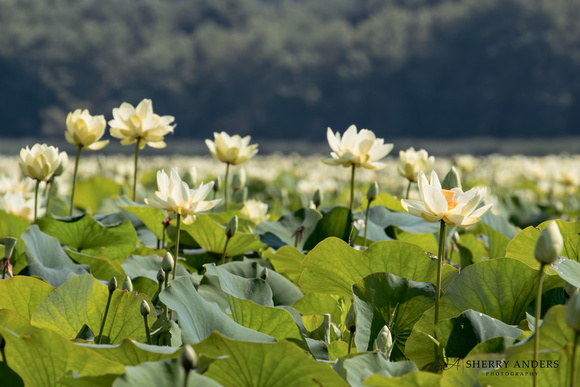
]]>
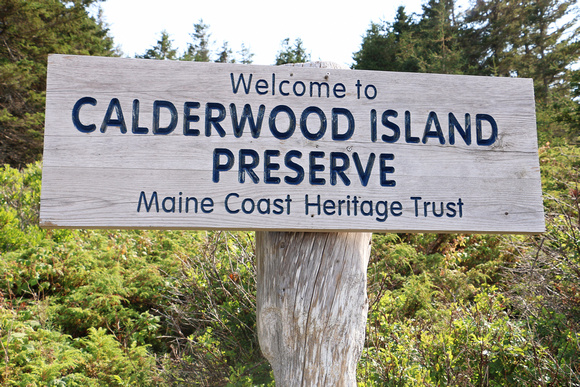 New Welcome Sign on Calderwood Island
New Welcome Sign on Calderwood Island
Calderwood Island, just off of North Haven Island in the East Penobscot Bay, is a narrow island with rocky beaches, stone cliffs, spruce forests, and large open areas covered in juniper shrubs. Arriving to the island, it is not unusual to find harbor seals hauled out on nearby ledges.
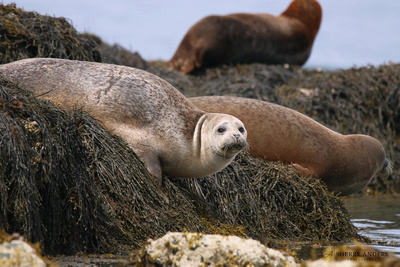 Harbor Seals
Harbor Seals
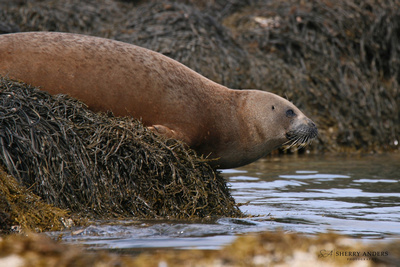 Harbor Seal
Harbor Seal
In the summer of 2015, we were surprised to find large areas of the island burned; we eventually learned that this was part of a series of controlled burns implemented by the Maine Heritage Trust to reduce the amount of juniper shrubs that have overtaken open areas, and to allow native plants to thrive. The picture below shows signs of new growth emerging from the charred landscape.
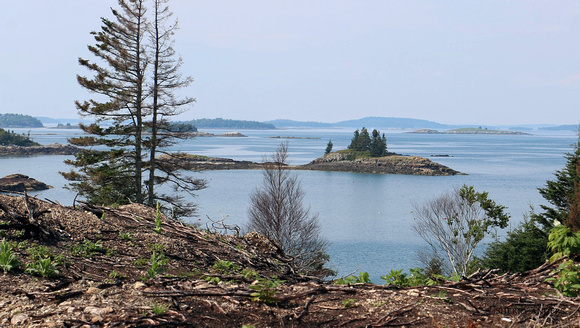 New Growth Emerging from the Charred Landscape
New Growth Emerging from the Charred Landscape
Further efforts toward this end have included adding three resident sheep: Cracker, Barrel, and Jack. Cracker and Barrel (both ewes) are the light-colored sheep, while Jack (a ram) is the brown sheep.
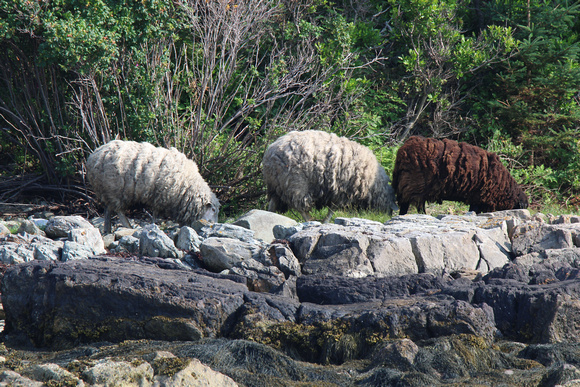 Cracker, Barrel, and Jack
Cracker, Barrel, and Jack
The sheep surprised us by coming down to the edge of the beach to graze, just as we were leaving the island.
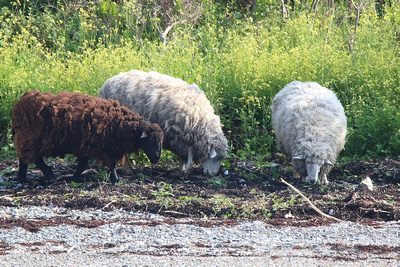 Cracker, Barrel, and Jack
Cracker, Barrel, and Jack
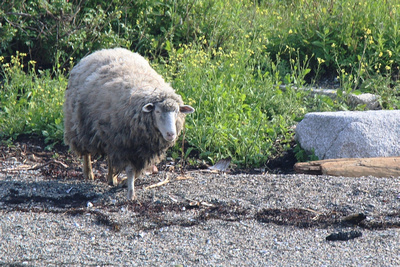 New Ewe on Calderwood Island
New Ewe on Calderwood Island
Having sheep on the island is not new; while there is no known history of permanent residents on the island, the Calderwood family previously used the island for sheep grazing, and the addition of Cracker, Barrel, and Jack mark a nostalgic return to the island's history.
“Come, my friends, ‘tis not too late to seek a newer world”
-Alfred, Lord Tennyson, “Ulysses,” engraved on the Thomas Cabot Granite Memorial Bench, Butter Island, ME
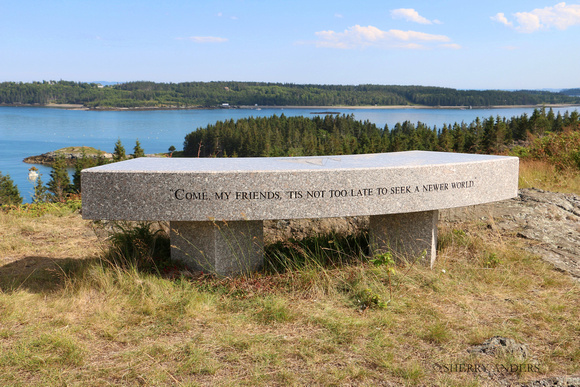 Tom Cabot Memorial Bench, Butter Island
Tom Cabot Memorial Bench, Butter Island
Great beaches and stunning views make Butter Island in Maine a favorite landing spot in the Penobscot Bay. The island was bought back in the 1940’s by Tom Cabot (of the famous Boston Cabots). Tom Cabot was an avid conservationist and wanted the island to be used and enjoyed by the public. The island became so popular, however, that it began to suffer from overuse. In the late 90’s the Cabot family decided to close part of the island to public access and enforce greater restrictions in an effort to preserve the island’s natural ecology. A caretaker resides on the island year round to ensure that the island is used and enjoyed properly.
Boaters and kayakers can land on Orchard Beach or Nubble Beach. On our most recent visit, we met the island’s caretaker and climbed to the top of 150 ft Montserrat Hill, where there is a great view of the Eagle Island Lighthouse and a granite bench memorializing Thomas and Virginia Cabot.
One of many terns fishing in the shallow waters off of Butter Island as we anchored the boat.
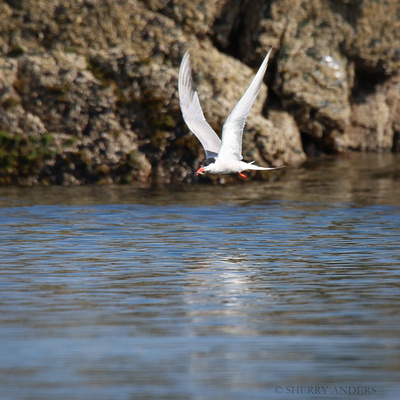 Tern with Fish, Butter Island, ME
Tern with Fish, Butter Island, ME
While most of the islands in Maine's archipelago have rocky beaches, Butter has some patches of sandy beach.
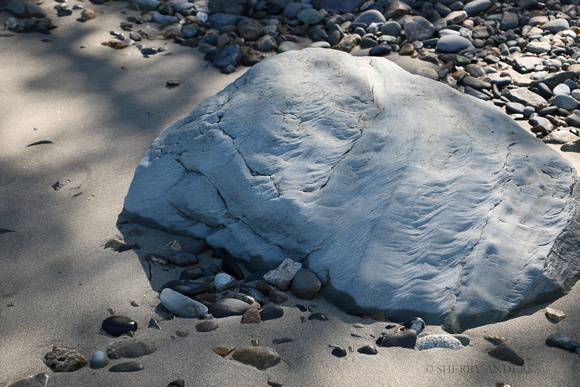 Sand Beach, Butter Island
Sand Beach, Butter Island
The "Welcome Center" on Nubble Beach, with maps, as well as the new rules and regulations.
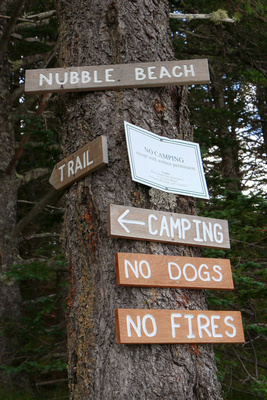 Nubble Beach, Butter Island
Nubble Beach, Butter Island
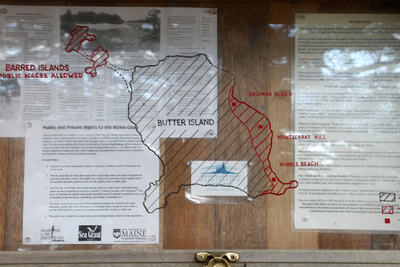 Butter Island Kiosk
Butter Island Kiosk
The trail, running partially through a wooded area, that leads to the top of Montserrat Hill.
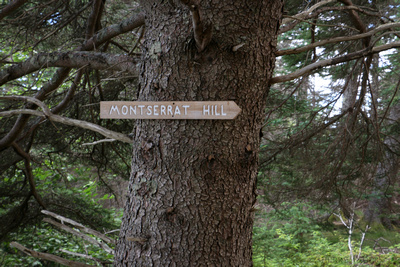 Trail Sign, Montserrat Hill
Trail Sign, Montserrat Hill
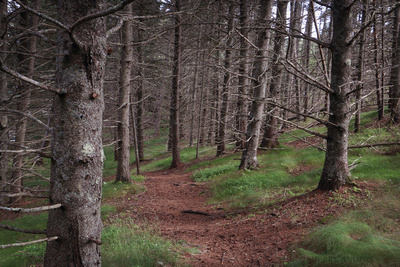 Trail to the top of Montserrat Hill
Trail to the top of Montserrat Hill
At the top of Montserrat Hill, The Thomas and Virginia Cabot Memorial Site with granite bench (picture above) and this placard.
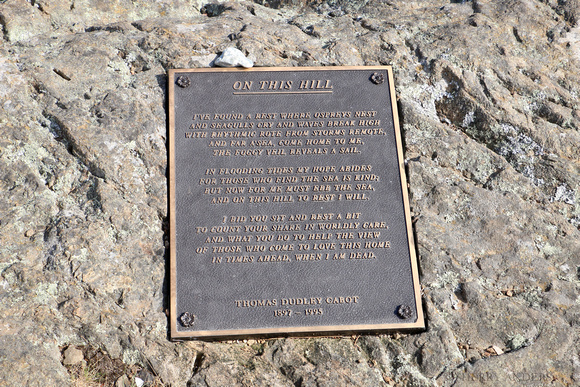 Tom Cabot Memorial Site
Tom Cabot Memorial Site
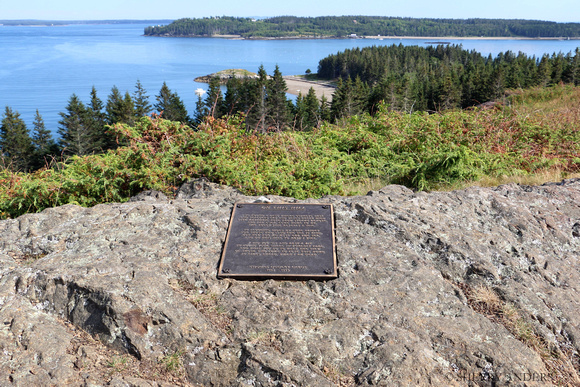 Tom Cabot Memorial Site
Tom Cabot Memorial Site
View from the top of Montserrat Hill; the Eagle Island Lighthouse is visible in the upper left corner of this photograph.
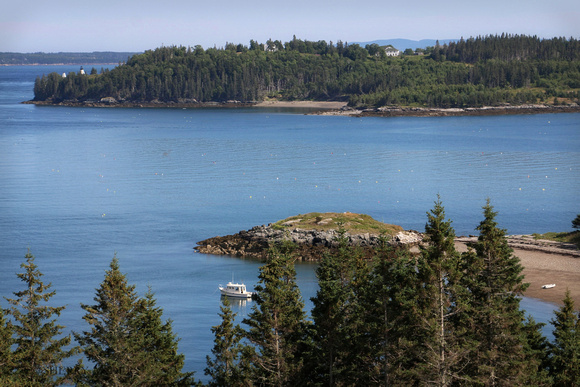 View from Montserrat Hill, Butter Island
View from Montserrat Hill, Butter Island
Other views from the top of Montserrat Hill, including a view of Mt. Megunticcok and the Camden Hills.
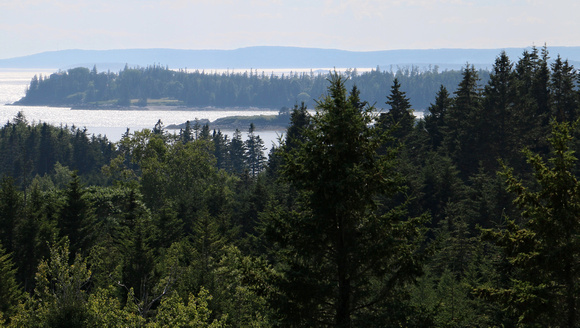 View from Montserrat Hill
View from Montserrat Hill
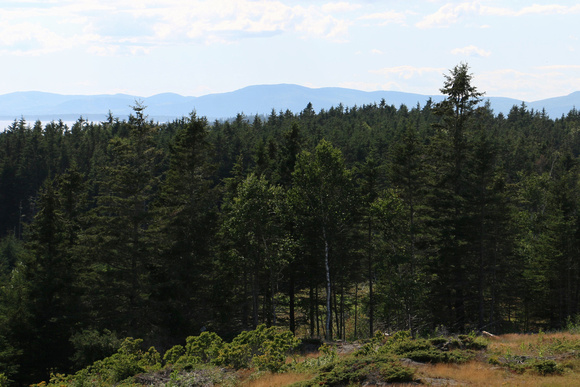 View of Mt. Megunticook and the Camden Hills
View of Mt. Megunticook and the Camden Hills
A Juvenile Yellow-Crowned Night Heron, and Beach Plums
 Juvenile Yellow-Crowned Night Heron
Juvenile Yellow-Crowned Night Heron
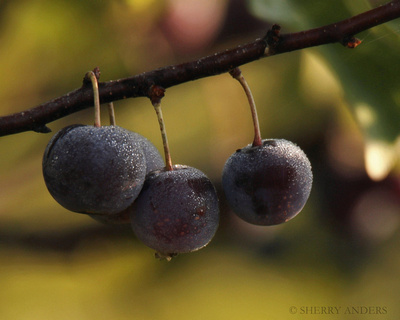 Beach Plums, Plum Island
Beach Plums, Plum Island
Least Sandpipers Hiding Out in the Glasswort, and Greater Yellowlegs
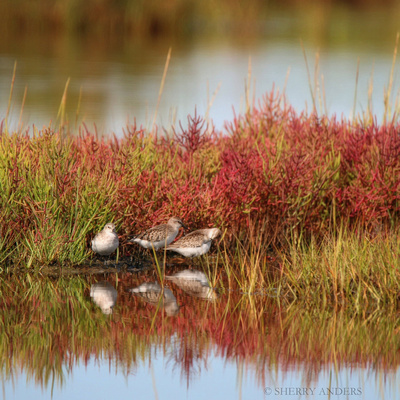 Least Sandpipers in the Glasswort
Least Sandpipers in the Glasswort
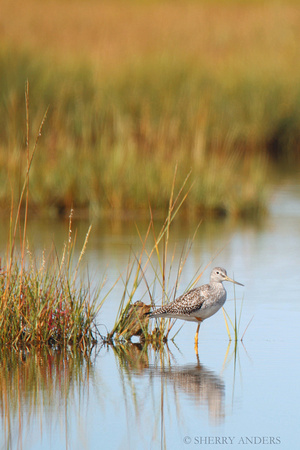 Greater Yellowlegs
Greater Yellowlegs
A Great Egret, and Three Great Egrets with a Snowy Egret
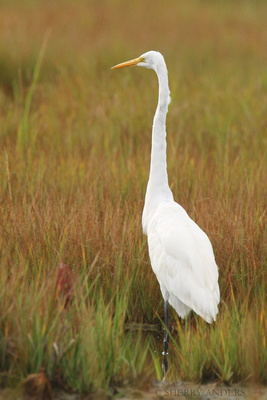 Great Egret
Great Egret
 Three Great Egrets, One Snowy Egret
Three Great Egrets, One Snowy Egret
A Lone Snowy Egret
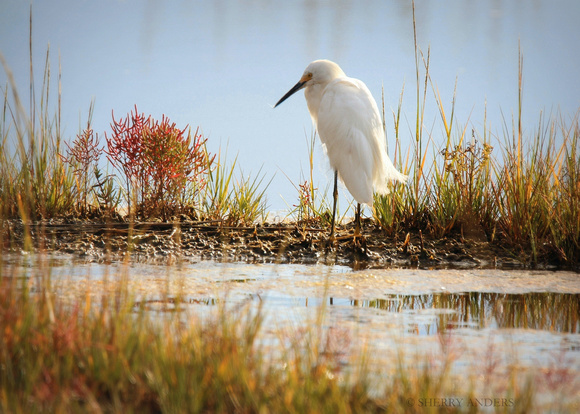 Snowy Egret
Snowy Egret
Great Egret Blue Heron on the Hunt for Polliwogs and Eels
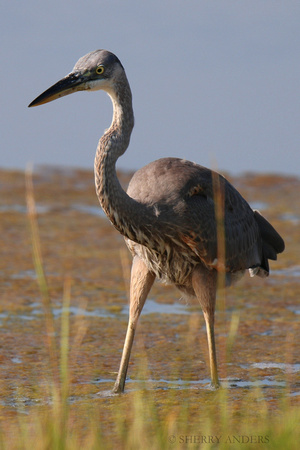 Great Blue Heron
Great Blue Heron
 Great Blue Heron
Great Blue Heron
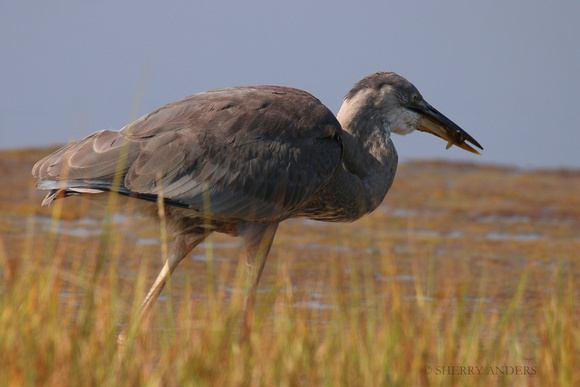 Great Blue Heron
Great Blue Heron
A Moon Shell Near the Water's Edge
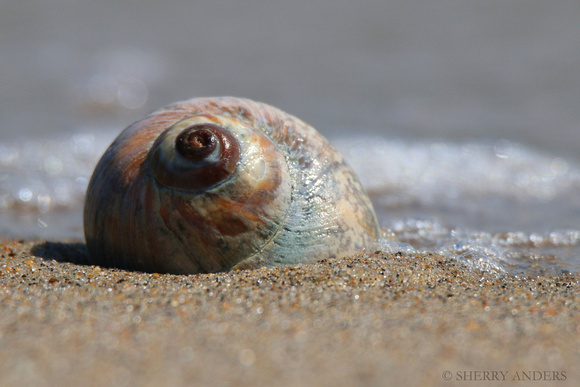 Moon Shell
Moon Shell
One of Two Bald Eagles Hunting in the Fields
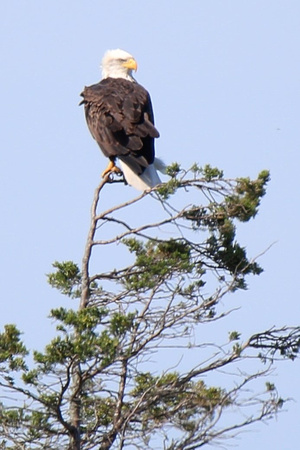 Bald Eagle
Bald Eagle
There is a palpable sense of remoteness that comes with visiting the beach during late fall and winter.
Every winter, snowy owls arrive from the arctic and take residence along the New England coast hoping to find food. In this area, they feast on a healthy supply of voles. Through the snow, a big, sleepy snowy owl was just barely visible across the Pannes.
 Snowy Owl
Snowy Owl
I found some dunlins resting along the shoreline; they looked completely tranquil in spite of the thunderous roar of the waves behind them.
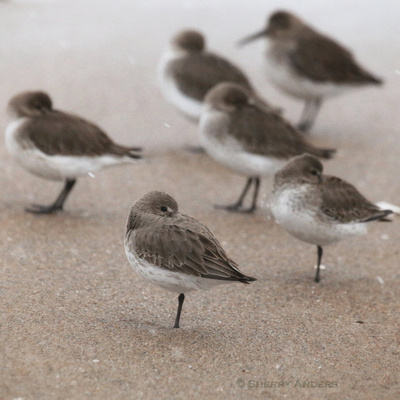 Dunlins
Dunlins
I left a long trail of footsteps in the powdered sugar-covered sand.

A late surprise, just before sunset, the clouds broke open and set the landscape ablaze with golden light.
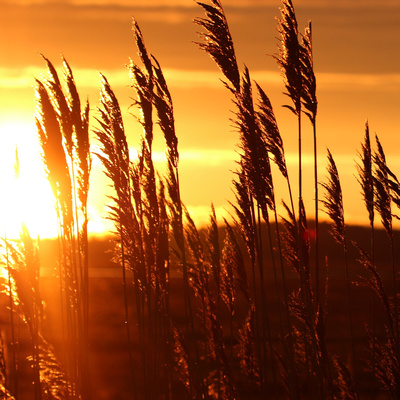
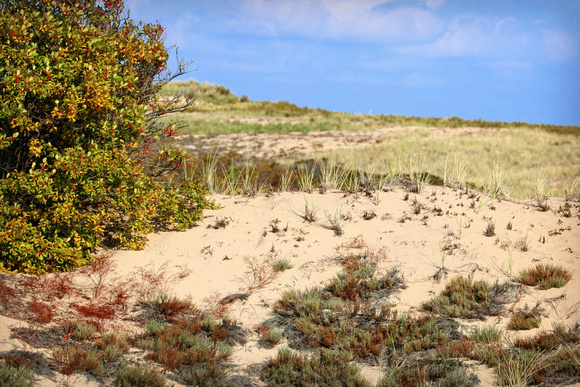 Plum Island Dunes
Plum Island Dunes
Plum island is a barrier island along the northern coast of Massachusetts, named after the beach plum shrubs that grow along its dunes. There are several pools that attract birds along the island's central road, as well as great ocean views and some forested areas.
 Great Egrets, Plum Island
Great Egrets, Plum Island
The fall colors were superb and there was an abundance of egrets along the pools. I counted well over a dozen Great Egrets and two Snowy Egrets.
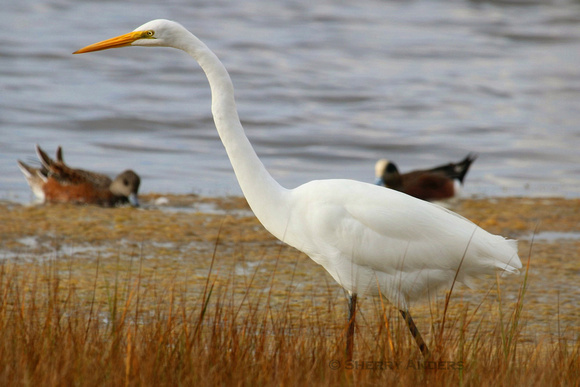 Great Egret with American Wigeons
Great Egret with American Wigeons
The sky was overcast for most of my visit, but the sun broke through just enough to get some beautiful close range shots of the birds.
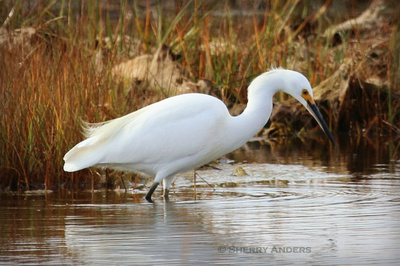 Snowy Egret, Plum Island
Snowy Egret, Plum Island
The pools were filled with a variety of ducks, including American and Eurasian Wigeons and Black Scoters. There were two Mute Swans and a number of Greater Yellowlegs along the grassy edges of the pools.
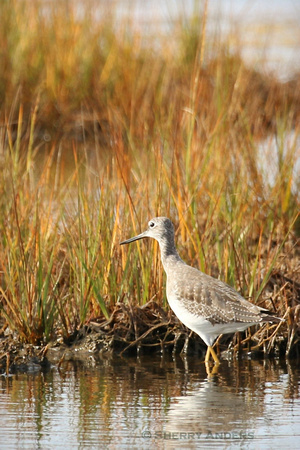 Greater Yellowlegs
Greater Yellowlegs
Turkey Vultures and a Sharp-shinned Hawk flew overhead. The Great Egrets, however, truly stole the show with their svelte all-white plumage, contrasting black legs, and blade-like bills. If the Great Blue Heron has "an eye like the full moon" (Mary Oliver, A Poem for the Great Blue Heron), its close cousin the Great Egret has an eye like the sun- bright, yellow, and fiercely intense. Once on the brink of extinction due to their prized feathers, the abundant egret population marks a conservation success story, commemorated in the image used in the National Audubon Society's logo.
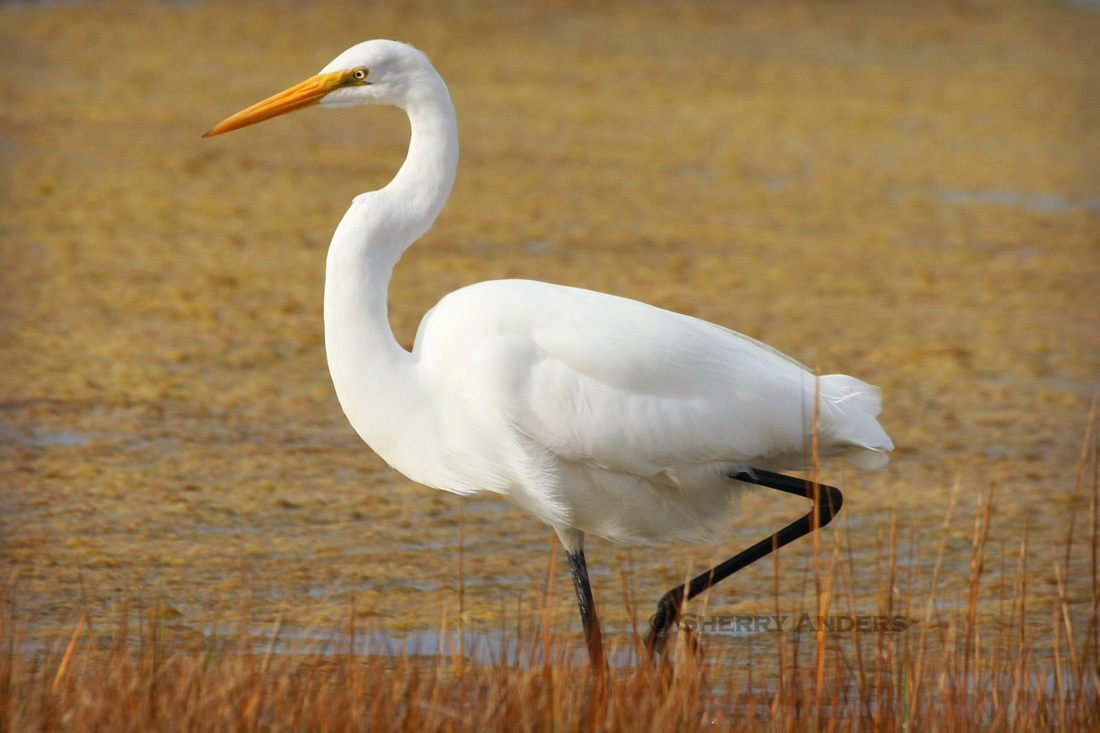 Great Egret, Plum Island
Great Egret, Plum Island
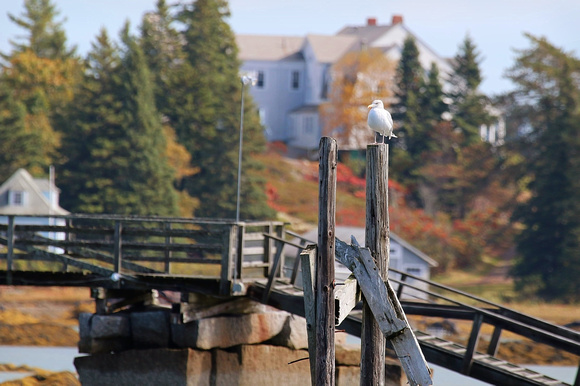
The ferry ride from Rockland to North Haven included a clear, bright view of the Camden Hills. One can easily see how Native Americans originally came to refer to the entire area as “Megunticook,” meaning “great sea swells,” as the hills appear to rise seamlessly from the ocean.
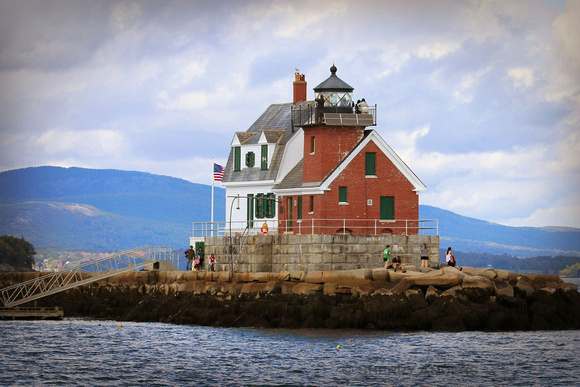 Rockland Breakwater Lighthouse
Rockland Breakwater Lighthouse
Mt. Megunticook, the tallest of the hills, can be seen behind the Rockland Breakwater Lighthouse in this photo.
Heading out close to dusk, I spotted a bald eagle and many young deer on the island.
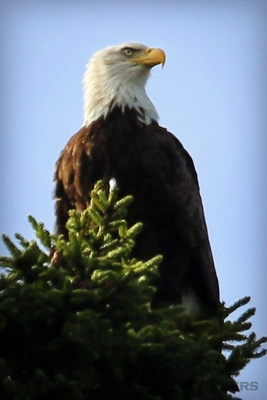 Bald Eagle
Bald Eagle
I found the usual crowd of plovers at Crabtree point.
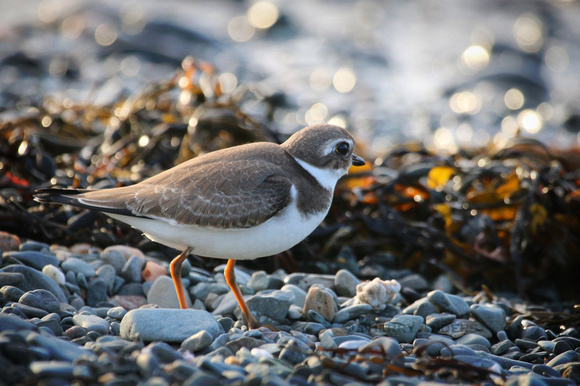 Semipalmated Plover
Semipalmated Plover
In the morning, I awoke to the sounds of raindrops, loons, and lobster boats. Even through the gray mist that enveloped the island, the bold colors of fall could be seen all around.
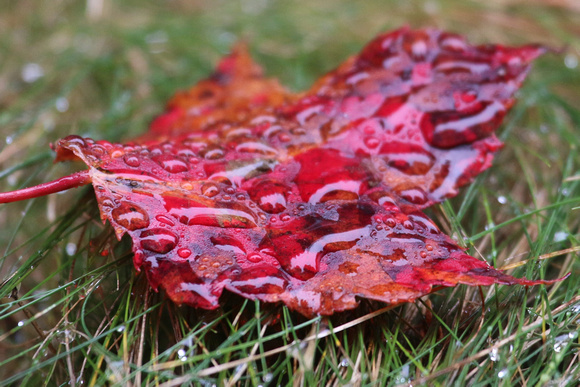 Fall Colors
Fall Colors
Bright skies returned the next day, as the sun broke through the fog and mist.
-----------------------------------------------------------
After returning to the mainland, the trip ended with a visit to Camden. In the harbor, alongside an array of impressive yachts and schooners, a variety of birds were perched on the rocks including gulls, cormorants, and ducks. White-crested ducks sported jaunty tufts on the tops of their heads that looked like George Washington wigs.
 Double-crested Cormorant
Double-crested Cormorant
A double-crested cormorant is perched on a rock at Camden Harbor.
The birds at the harbor seemed unusually comfortable with human visitors getting close to them.
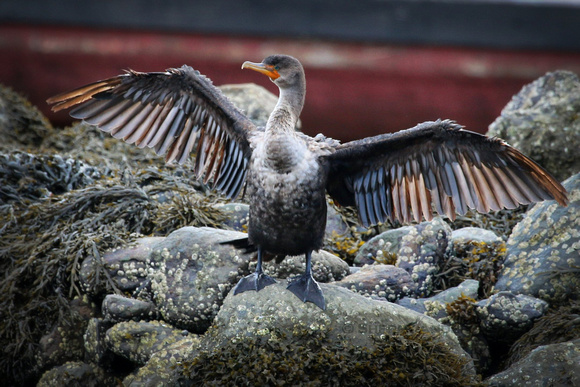 Double-crested Cormorant
Double-crested Cormorant
This was followed by a drive to the top of Mt. Battie, overlooking Camden Harbor, where the fall foliage and the views of the Penobscot Bay were spectacular. North Haven can be seen along the horizon, to the far left.
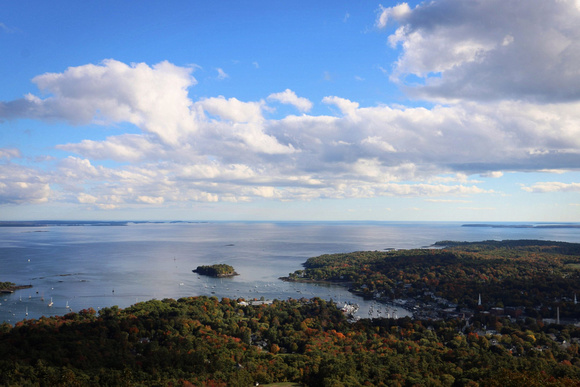 View from Mt. Battie, Camden, ME
View from Mt. Battie, Camden, ME
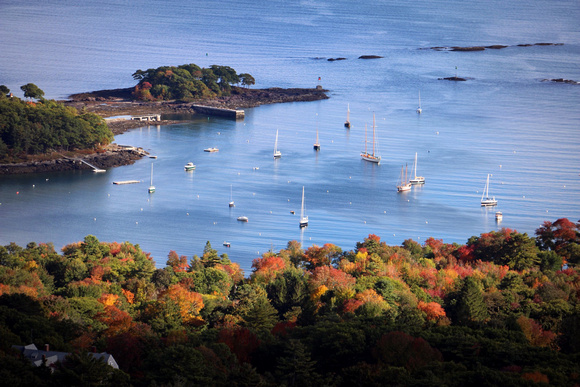 View from Mt. Battie, Camden, ME
View from Mt. Battie, Camden, ME
]]>
-Mary Oliver, from A Poem for the Blue Heron
The Great Blue Heron is the largest North American Heron, common near open shores and in wetland areas. In the shallow waters, herons feast on frogs and fish, but will also eat snakes, small mammals, other birds, and insects.
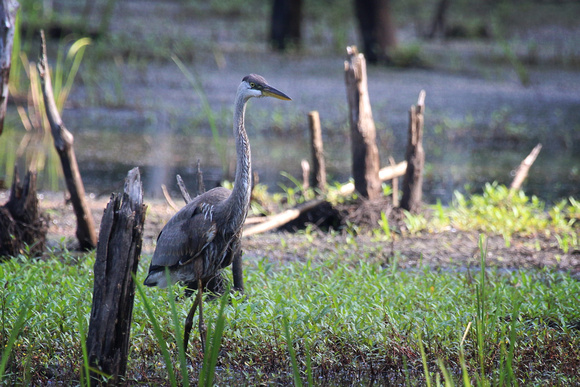 Great Blue Heron
Great Blue Heron
Brilliantly camouflaged, from a distance this heron was virtually indistinguishable from the decaying stumps.
These solitary lurkers show up in the works of several well-known poets, including a number of of Mary Oliver's poems; in this piece, Theodore Roethke pays homage to their masterful grace and agility:
The Heron
By Theodore Roethke
The heron stands in water where the swamp
Has deepened to the blackness of a pool,
Or balances with one leg on a hump
Or marsh grass heaped above a muskrat hole.
He walks the shallow with an antic grace.
The great feet break the ridges of the sand,
The long eye notes the minnow's hiding place.
His beak is quicker than a human hand.
He jerks a frog across his bony lip,
Then points his heavy bill above the wood.
The wide wings flap but once to lift him up.
A single ripple starts from where he stood.
Great Blue Heron
]]>
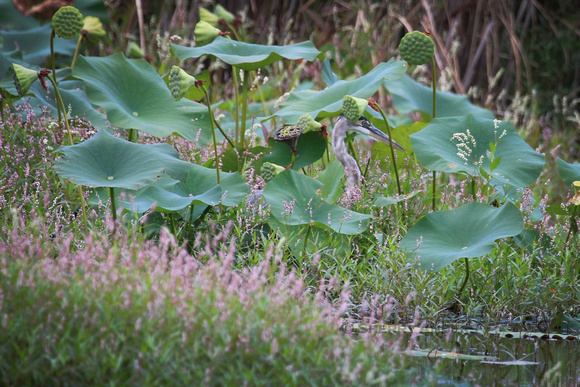 Juvenile Great Blue Heron under Lotus Leaves
Juvenile Great Blue Heron under Lotus Leaves
Adding a touch of whimsy, a dragonfly landed on the heron’s bill.
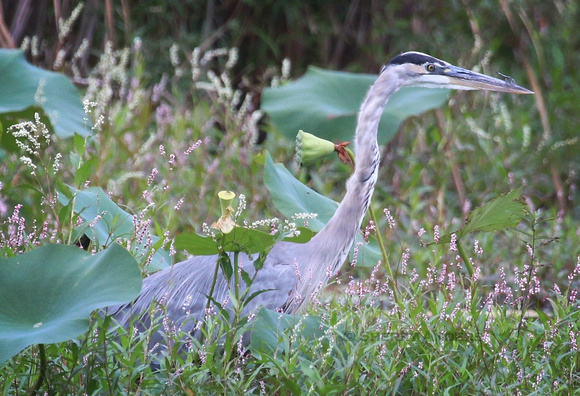 Dragonfly Perched on the Bill of a Great Blue Heron
Dragonfly Perched on the Bill of a Great Blue Heron
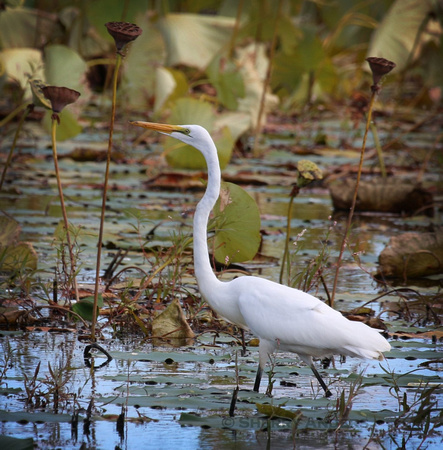 Great Egret
Great Egret
Bright and breezy, the leaves had begun to turn. Walking around the pools I was greeted by a variety of wildlife including mallards and black ducks, Canada geese, brightly colored insects, painted turtles, and a leopard frog.
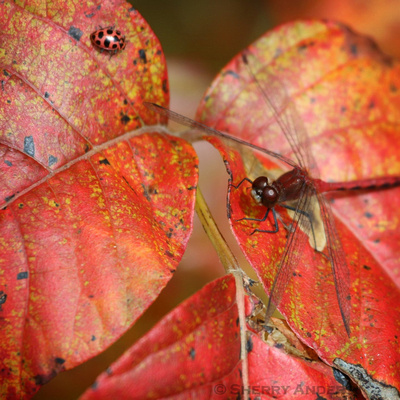 9-Spotted Leaf Beetle and Ruby Meadowhawk
9-Spotted Leaf Beetle and Ruby Meadowhawk
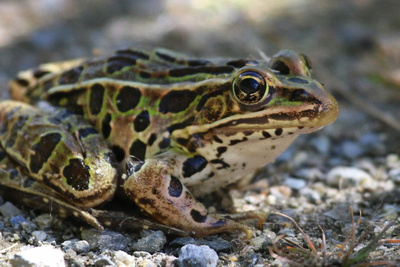 Leopard Frog
Leopard Frog
Milkweed seed pods along the side of the path were covered in bright orange milkweed beetles.
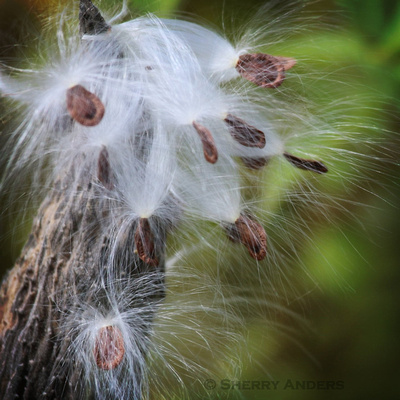
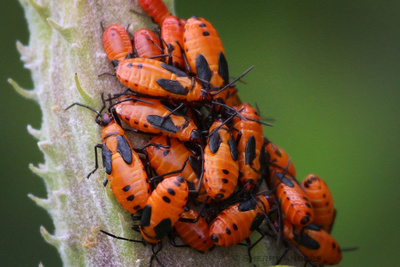 Milkweed Beetles
Milkweed Beetles
On the bank of the Concord River near the lower pool, a juvenile double-crested cormorant was taking in the sun.
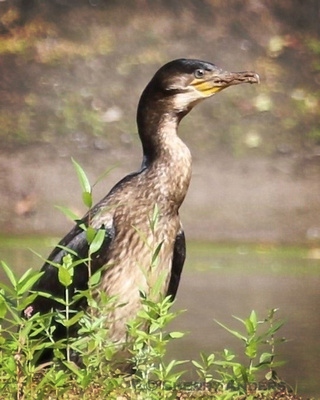 Double-crested Cormorant, Juvenile
Double-crested Cormorant, Juvenile
]]>